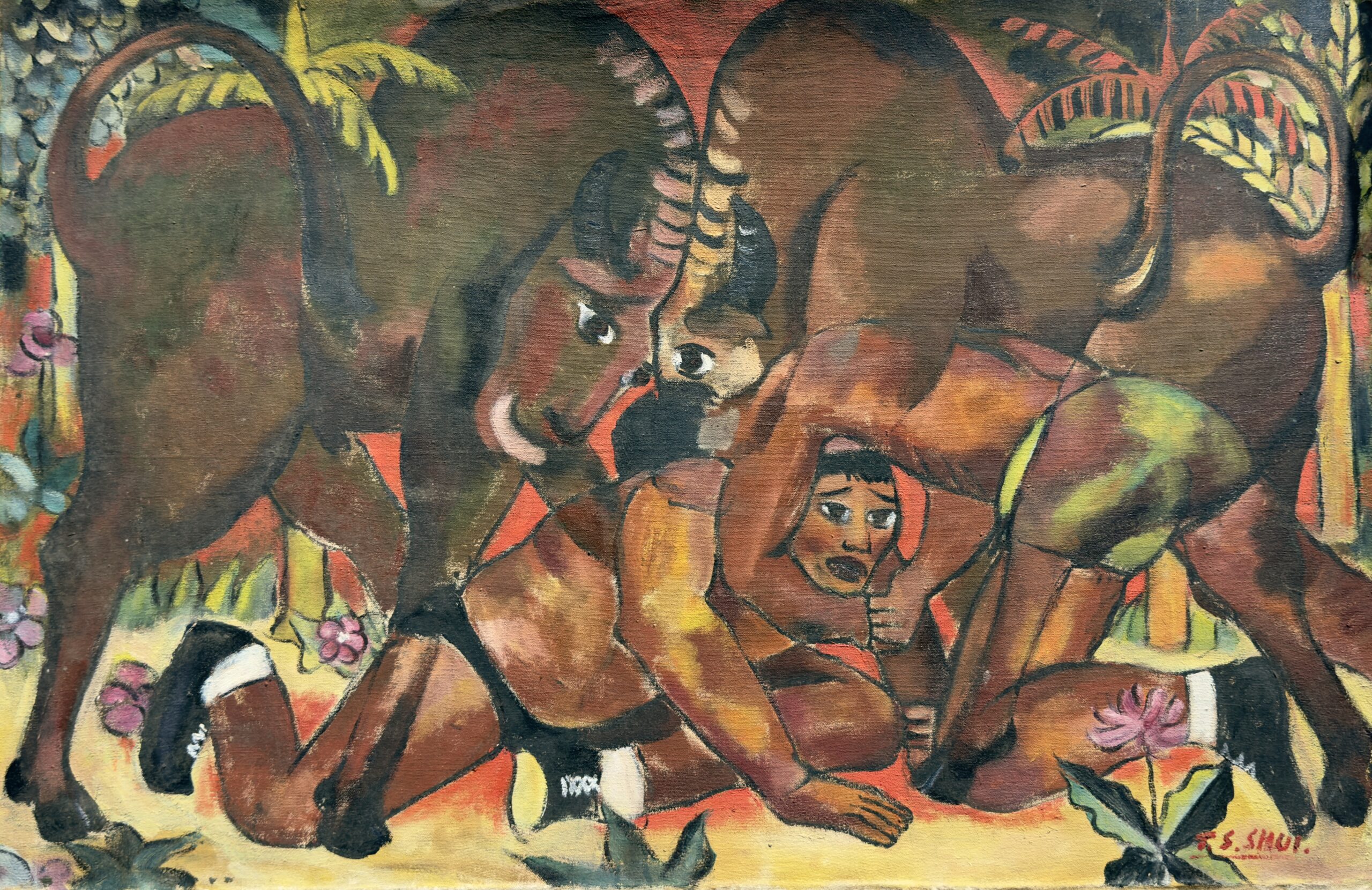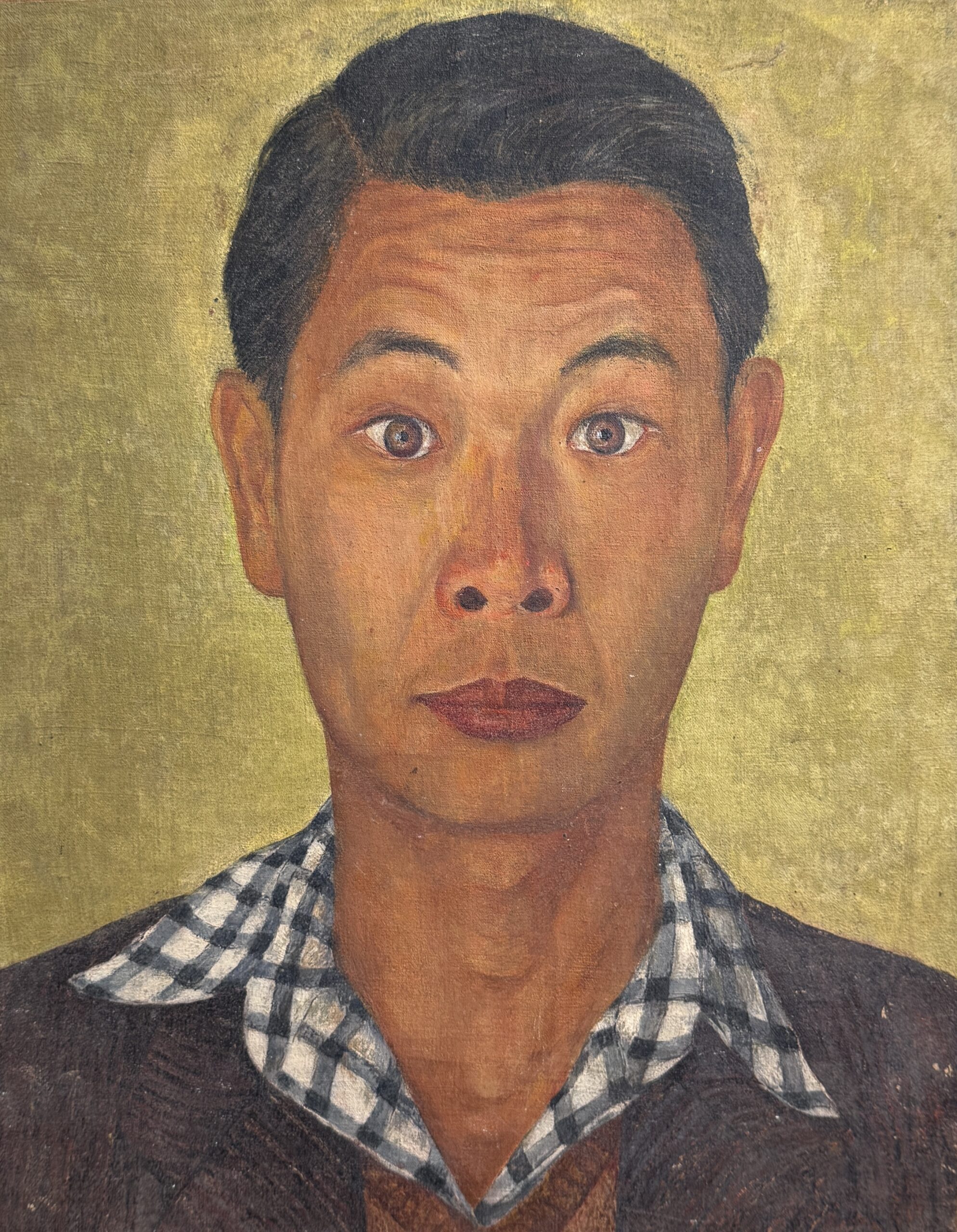From China to Singapore: Rediscovering the Artist Shui Tit Sing
Shui Tit Sing (1914–1997), an artist who migrated from China to Southeast Asia, spanned both painting and sculpture, capturing local humanistic concerns and the spirit of Eastern aesthetics with sincere and unpretentious brushwork. Prestige Gallery presents (Re)discovering Shui Tit Sing, the first major solo exhibition offering a comprehensive retrospective of his artistic career. Combining a rich selection of works and archival materials, the exhibition aims to reestablish his place in Singaporean and Asian modern art history.

Shui Tit Sing’s oil painting Wrestlers (1949–1952) has been praised in English-language art reviews for its distinct Malayan style. (Courtesy of Prestige Gallery)
Among Chinese artists who moved south, Shui Tit Sing is one whose legacy had been largely forgotten. Despite a lifelong dedication to diverse artistic media, he had very few opportunities to exhibit his works during his lifetime. In 1982, the National Museum of Singapore displayed his woodcarving for only two days. Independent art historian Koh Nguang How organized Shui Tit Sing – Centennial Historical Exhibition in 2014 at the Gillman Barracks Contemporary Art Centre. Now, Prestige Gallery’s (Re)discovering Shui Tit Sing marks the first comprehensive large-scale solo exhibition of his career. With the forthcoming publication of his complete works, the exhibition seeks to reconstruct Shui Tit Sing’s significance in Singaporean and Asian modern art history.
Praised for his “iron will” by Lin Fengmian
Curated by Audrey Zhang and Rick Shi of Prestige Gallery, with Koh Nguang How as curatorial advisor, the exhibition unfolds in two phases. The first phase traces Shui Tit Sing’s life and works from 1934 to 1961, presenting over 50 pieces across oil, watercolor, ink, sketch, woodcut, photography, and woodcarving. It also systematically showcases archival materials including teaching notes, letters, interviews, photographs, and books, offering a multi-dimensional portrait of the artist and his historical context. The second phase, planned for the coming years, will focus on his works from 1961 until his passing, including woodcarvings, ink paintings, and interactions with the Ten Men Group.

Shui Tit Sing’s oil self-portrait (1939–1940). (Courtesy of Prestige Gallery)
Born on November 25, 1914, in Kaiping, Guangdong, Shui Tit Sing graduated from Guangzhou Peiying Middle School, studying drawing, oil painting, and photography under He Tieh Hua. At school, he frequently organized art exhibitions and, at 19, owned a German Ermanox camera renowned for low-light photography. From 1937 to 1940, he studied painting at the National Art Academy in Hangzhou (now China Academy of Art), learning from Lin Fengmian, Pan Tianshou, Wu Dayu, Chang Shuhong, and Guan Liang.
In a 1937 photograph gifted to Shui Tit Sing, principal Lin Fengmian wrote: “You truly possess an ‘iron will.’ Always maintain your attitude; after we part, this is my hope for you.” In 1940, teacher Chang Shuhong advised him: “Always observe nature with sincere emotion; anything fictitious or insincere is not the pursuit of a true artist.” Shui Tit Sing kept many such documents, including Dunhuang painting albums studied by Chang.
Works acquired by China Academy of Art
Shui Tit Sing was a close friend of Zao Wou-Ki and senior to Chu Teh-Chun and Wu Guanzhong. Zao gifted him a still life painting in 1937, writing: “Challenges await you to overcome.” After over a decade of research, Koh Nguang How revealed in 2018 that the China Academy of Art has started to recognize alumni beyond Zao, Chu, and Wu, acquiring 13 of Shui Tit Sing’s works from his China period, which will be exhibited during the Academy’s centennial in 2028. Two years ago, Shui’s family donated eight photo albums to the Academy. Koh Nguang How noted, “Shui Tit Sing was almost like an archivist. His photographs and materials provide invaluable insight into the Academy’s history and other alumni.”
Rick Shi emphasized that National Hangzhou College of Art’s collection of art books—14,000 volumes, including 2,000 Western art books—was highly influential. Shui Tit Sing, however, preferred Eastern art and in 1941 published an artistic manifesto, believing that art could thrive in Malaya. His experience in Southeast Asia was akin to that of Western painter Paul Gauguin.
Art that captures life and humanity
Shui Tit Sing’s China-period works include elegant Republican-era mounting, sketches of wartime refugees in Guiyang stamped with “blood flower” seals, tranquil nude oil paintings with still-life accompaniments, and self-portraits showing his character. Many of these oil paintings were stored under his bed for years before rediscovery. His watercolors remain vivid and unblemished even decades later.
In Malaya and Singapore, he captured local scenery and people: Jinrikisha station on Maxwell Road (1940), coconut groves in Kampong (1941), tram tracks at Clifford Pier (1948), workers along the Kallang River (1950s), Malay youths playing chess under a tree, Balinese dancers, wrestling matches, and fishing scenes in the Kallang estuary. His works range from figurative to abstract. One 3-meter-long watercolor depicts Singapore’s transformation from Kallang to the modern city.
Shui Tit Sing’s wartime woodcuts were lost, but he produced woodcuts reflecting daily life in the 1950s. In 1963, a trip with the Ten Men Group to Cambodia inspired his compositional and figurative style from Angkor reliefs. From 1968, he focused on teak sculptures of dancers, fishermen, dragon boat races, and Thaipusam ceremonies, combining simplicity with group spirit and rhythm of life—pioneering modern woodcarving in Southeast Asia.
Teacher nicknamed “Iron Bull”
After graduation, wartime conditions prevented him from going to France. Recommended by his Singaporean classmate Tay Tian Song, he traveled via Yunnan and Burma, arriving in Malaya in late 1940. From 1941 to 1945, he taught at Chung Hua High School, Kuala Pilah, later settling in Singapore. Between 1948 and 1977, he taught art and Chinese at the Catholic High School, mentoring students including Chua Ek Kay, Choo Keng Kwang, and Ling Yang Chang. Known for his strictness, students nicknamed him “Iron Bull.” In 1949, he worked briefly as a photographer for Nanyang Siang Pau.
Shui Tit Sing’s works are grounded in everyday life and human experience, blending local sensibilities with Eastern aesthetics. His wife opposed his art, but he persisted with his “iron will,” never abandoning his practice.
Exhibition details
Rediscovering Shui Tit Sing runs until October 9, 2025, at Prestige Gallery, 39 Keppel Road #03-01, Singapore 089065. Hours: Tuesday–Saturday, 11 am–7 pm; Sunday, 12 pm–5 pm. On August 23 at 3 pm, Xu Yuanhao will give an English talk on Shui Tit Sing. Admission is free.


